To build a successful small business, you need marketing tactics that fit your budget.
Use our small business marketing tips to improve your online presence, build relationships with customers, and plan for strategic growth.
Online Presence Small Business Marketing Tips
With digital marketing, you can promote your business online using search engine optimization (SEO), email marketing, social media marketing, and more channels.
These digital marketing tips for small businesses focus on organic methods, meaning they don't rely on paid advertising.
Optimize Your Website
Optimizing your website can improve its visibility on search engine results pages (SERPs). As a result, your site will be more likely to rank toward the top of relevant search results.
Why does that matter?
The top search result on a Google SERP gets an average of 27.6% of clicks, according to Backlinko. Optimizing your site to rank in one of the top positions (ninth or higher) on a SERP can help you drive more traffic.
Developing an SEO strategy involves many different elements. To start, use Semrush's Site Audit tool. Once you enter your domain, you'll see a dashboard like this:
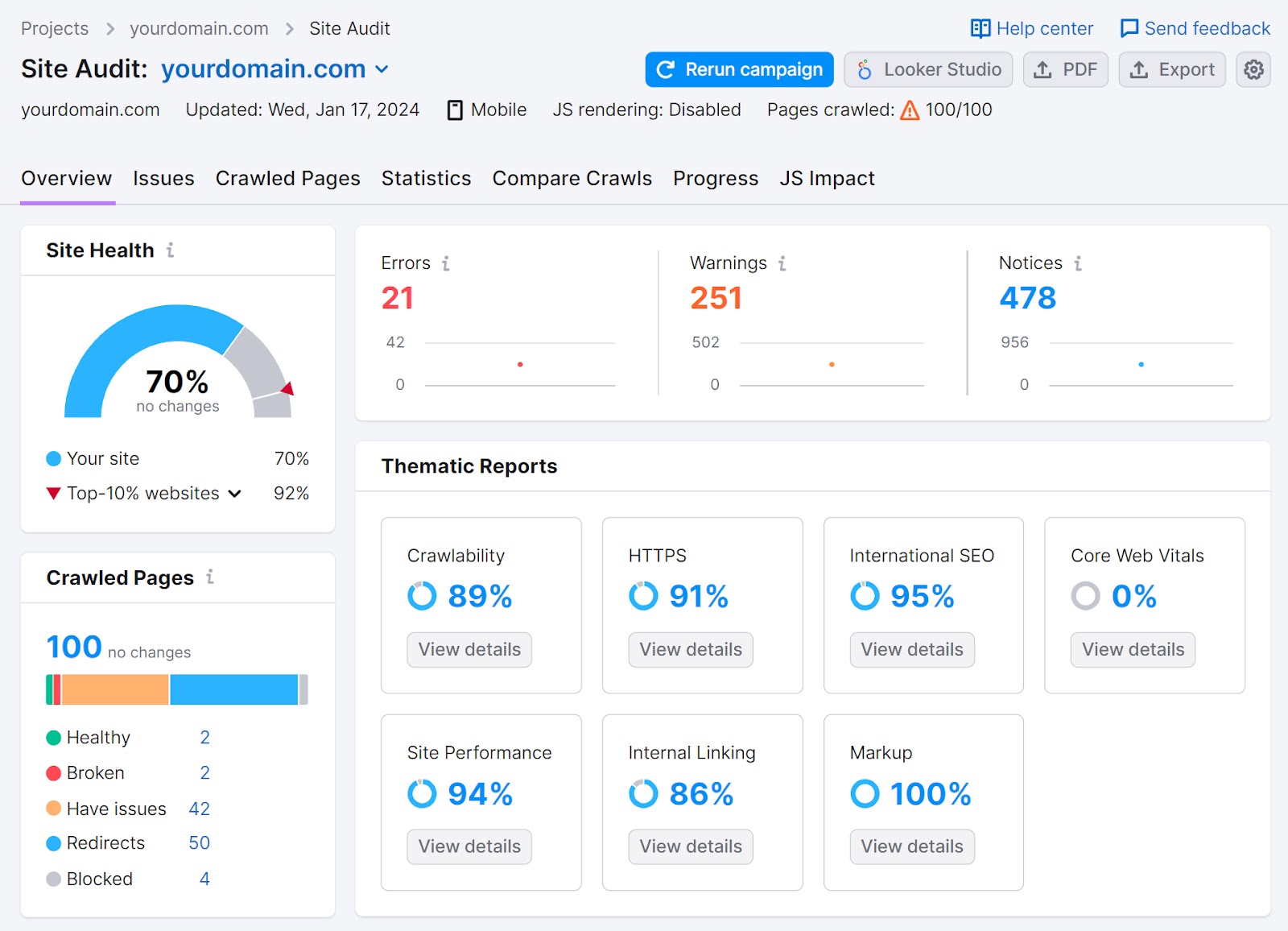
This SEO software displays the health of your website and shows:
- On-page (internal) SEO elements like meta descriptions, which you can manage by manually optimizing the webpage
- Off-page (external) SEO elements like backlinks, which you can influence via link building outreach, but can't directly control
Click to view the "Issues" tab on the dashboard to see critical errors and actionable tips to fix them.
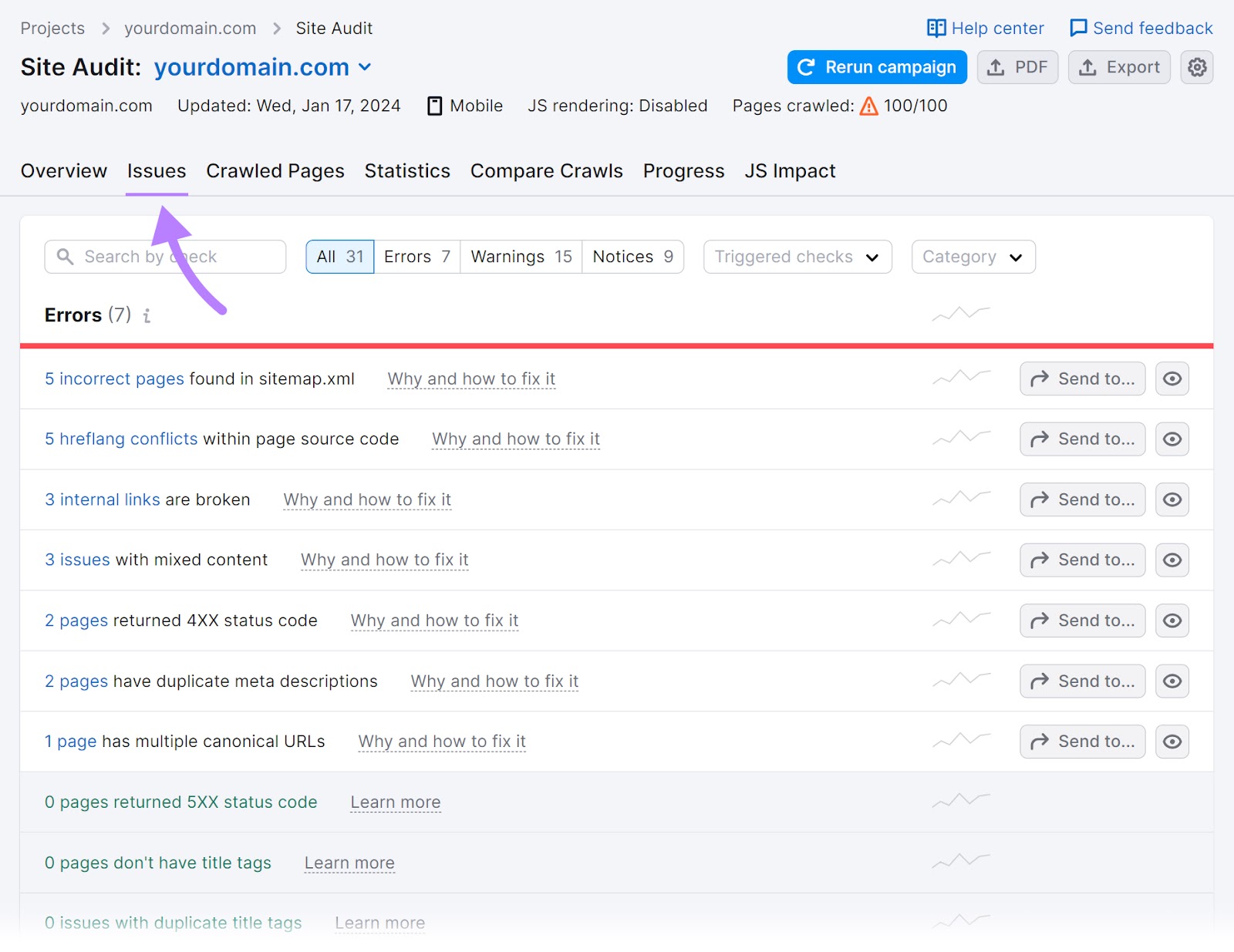
To optimize your website, you should also:
- Check Position Tracking to monitor keyword rankings, estimated search traffic, and top-ranking pages
- Implement mobile SEO tactics like responsive design and optimize for voice search
- Use On Page SEO Checker to get ideas for content to publish, backlinks to pursue, and user experience (UX) updates to make
Create Quality Content
Quality content is written, visual, audio, or video marketing content that's accurate, well-researched, and aligns with website visitors' search intent.
In other words, it reliably answers questions and covers topics that users are searching for when they click through from search results.
Content marketing comes in many forms, including:
- Blog posts
- Infographics
- White papers
- Videos
- Podcasts
Why is high-quality content so important?
It can build trust in your small business, increase conversions (e.g., leads or purchases), retain customers, and improve search engine rankings.
Use Semrush's SEO Writing Assistant to help you more efficiently produce valuable content.
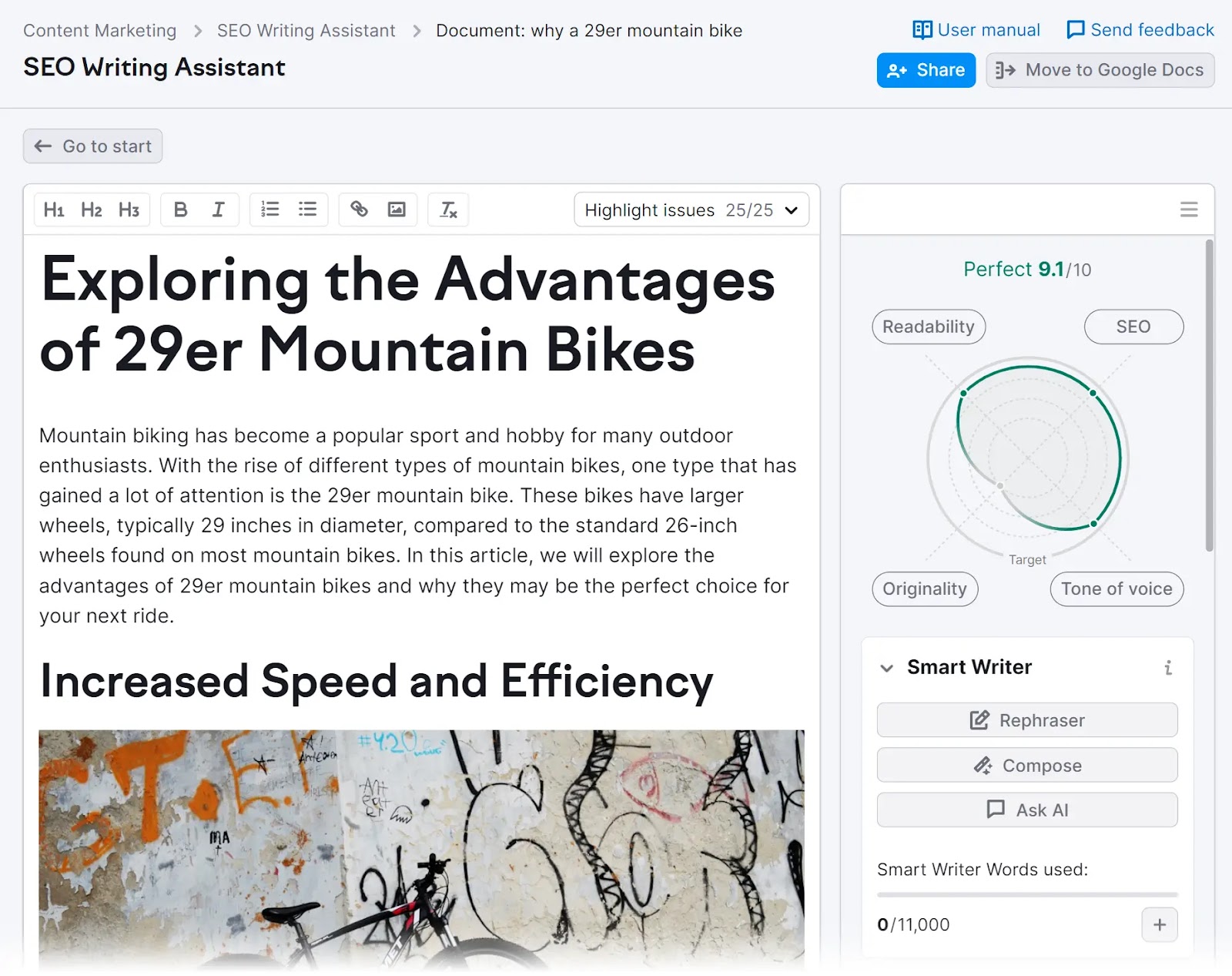
It analyzes written content and recommends changes to optimize for:
- SEO, including keywords and links
- Readability, i.e., how easy the piece of content is to read
- Tone of voice, e.g., striking a balance between formal and casual tone
- Originality, meaning it’s free from plagiarism
Publish Case Studies
Case studies, also known as customer stories, are a written or video content marketing tool that shares how your business helped customers meet a goal or overcome a challenge. They typically include three main parts:
- Challenge: What the customer wanted to achieve, including problems they encountered while trying to find a solution themselves
- Solution: How your business partnered with the customer, including details on the products or services your company provided
- Result: The results your customer achieved by partnering with your business
Case studies show what your small business can help customers achieve. They also serve as social proof, which can make other customers more likely to do business with you.
To make case studies easy for prospects to find, consider publishing them in a dedicated location on your website. For example, Semrush publishes success stories on a page with options to sort by industry, client type, or company size, helping prospects easily find relevant case studies.
Focus on Local SEO
Local SEO helps businesses with brick-and-mortar locations be more visible online. In addition to attracting website traffic, local SEO can also drive foot traffic.
However, local SEO isn't a replacement for standard SEO. It's another form of marketing exclusive to physical businesses.
To manage local SEO:
- Use the Keyword Magic tool to find local keywords and attract search traffic from customers near your business
- Optimize your Google Business Profile (formerly Google My Business) so your business appears on Google Maps and in local search
- Add your business to local directories to reach a customer base in your area
Manage your Google Business Profile and local directory listings with Semrush's Listing Management tool.
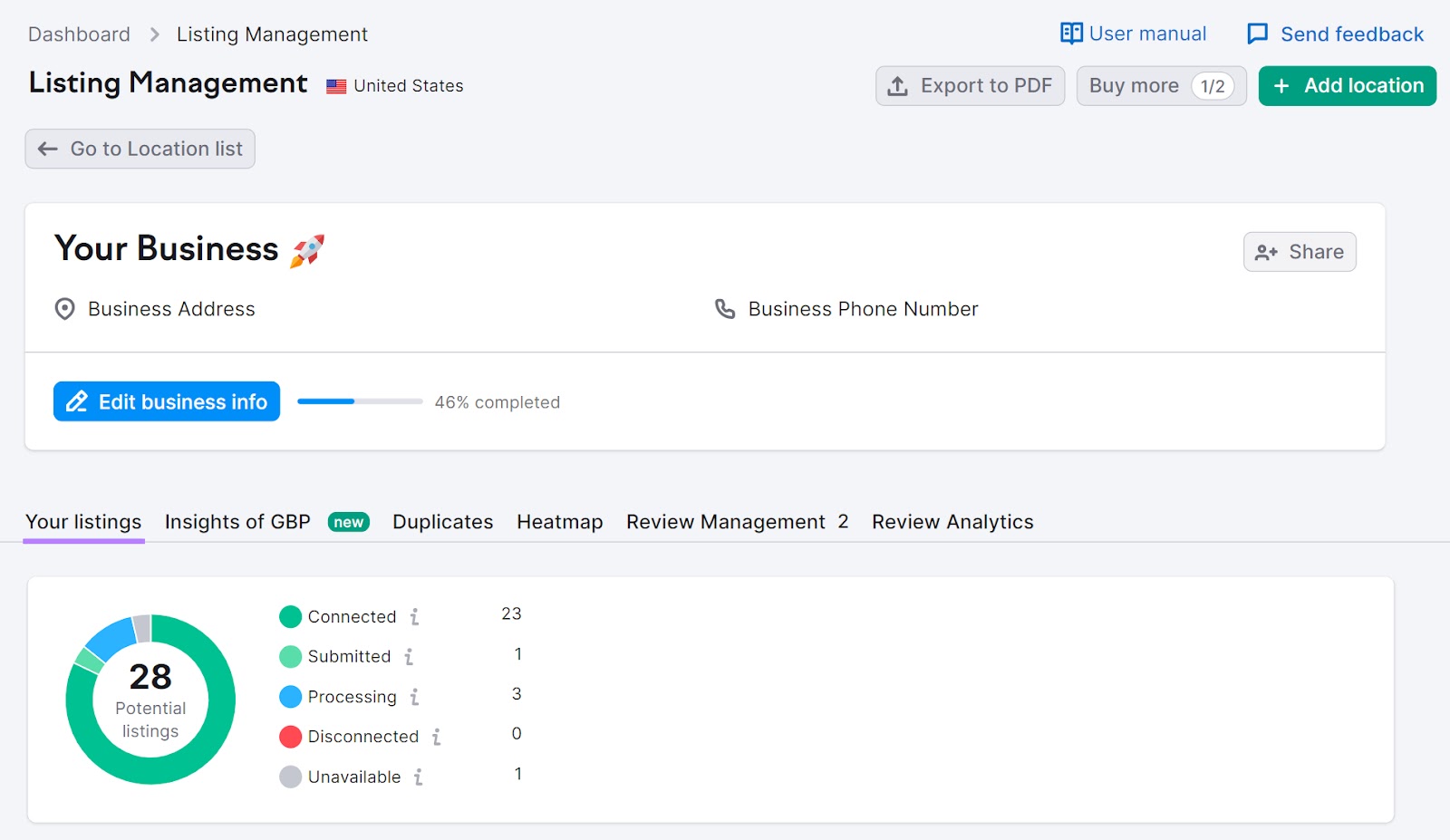
This dashboard keeps track of listing statuses and helps you remove duplicate listings to ensure your local business is accurately represented online.
Leverage Social Media Platforms
Social media marketing can make your small business more visible on platforms like Facebook, Instagram, TikTok, and LinkedIn. By marketing your small business on social media, you have the potential to reach 5.04 billion people, including your ideal customer.
So, which social media channel is right for your small business?
Use One2Target to analyze your audience. Input your website, and then navigate to the "Behavior" tab.
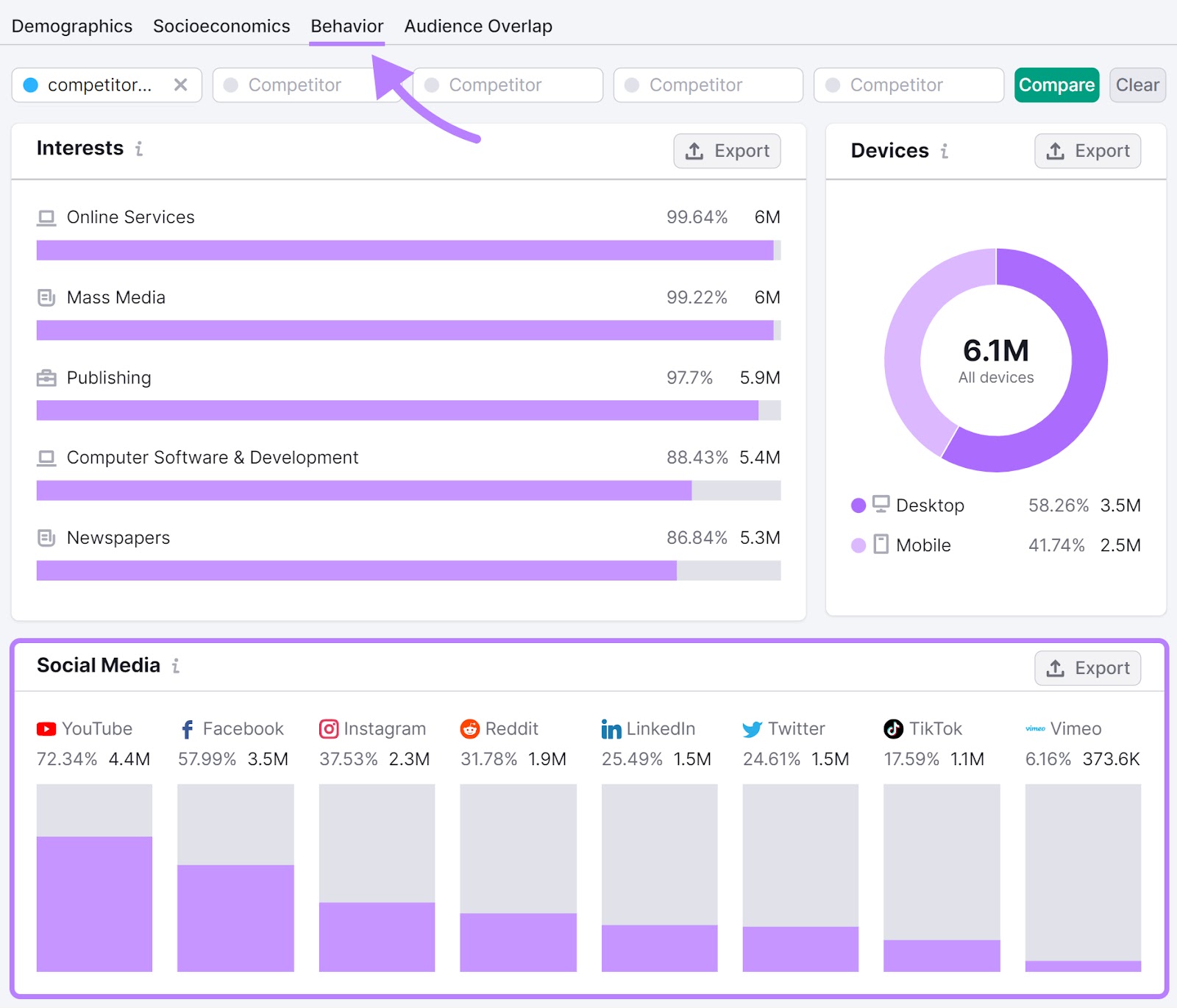
The "Social Media" panel shows the platforms your audience uses most. To make the most of your marketing dollars, plan to invest in those platforms.
To establish a strong brand presence on social media:
- Optimize your social media profiles with accurate business information and website links
- Publish social media posts, stories, and short-form videos regularly (e.g., daily or weekly)
- Respond to direct messages (DMs) from customers and comments on your social media posts
- Review social media analytics to see which content drove the most likes, comments, or clicks
- Use your top-performing posts to serve as models for more engaging social media content
Track audience growth, post reach (the number of people who see your posts), and post engagement (the number of people who comment or like) with Semrush's Social Analytics tool.
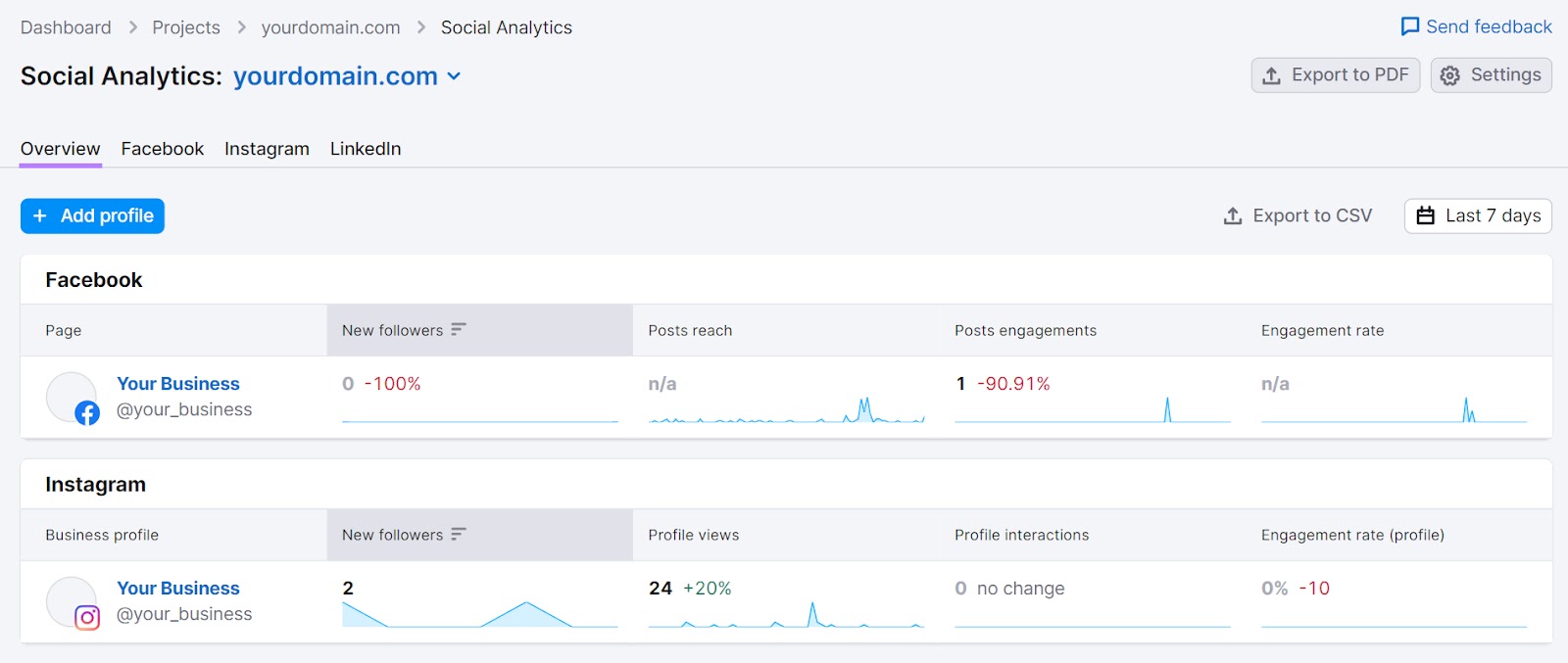
Use this data to identify top-performing accounts and content. Replicate these tactics to continue building your social media presence.
Engage in Email Marketing
With an email marketing strategy, you promote your small business via email newsletters and offers.
Why should you consider building an email list?
Email marketing campaigns have some of the highest return on investment (ROI) metrics of any marketing channel. On average, brands earn $36 for every $1 they invest in email campaigns.
One of the reasons email campaigns are so cost-effective is that they can reach highly specific customer groups via one-time messages or drip campaigns (email series that send over time).
Most email marketing tools let you segment subscribers based on behaviors, like making a purchase.
As a result, you can ensure each message goes to the subscribers who are most likely to open, read, and take action, like visiting a webpage or adding an item to their shopping cart.
To grow your email list faster, offer an incentive. For example, Counter Culture Coffee offers a discount to new email subscribers.
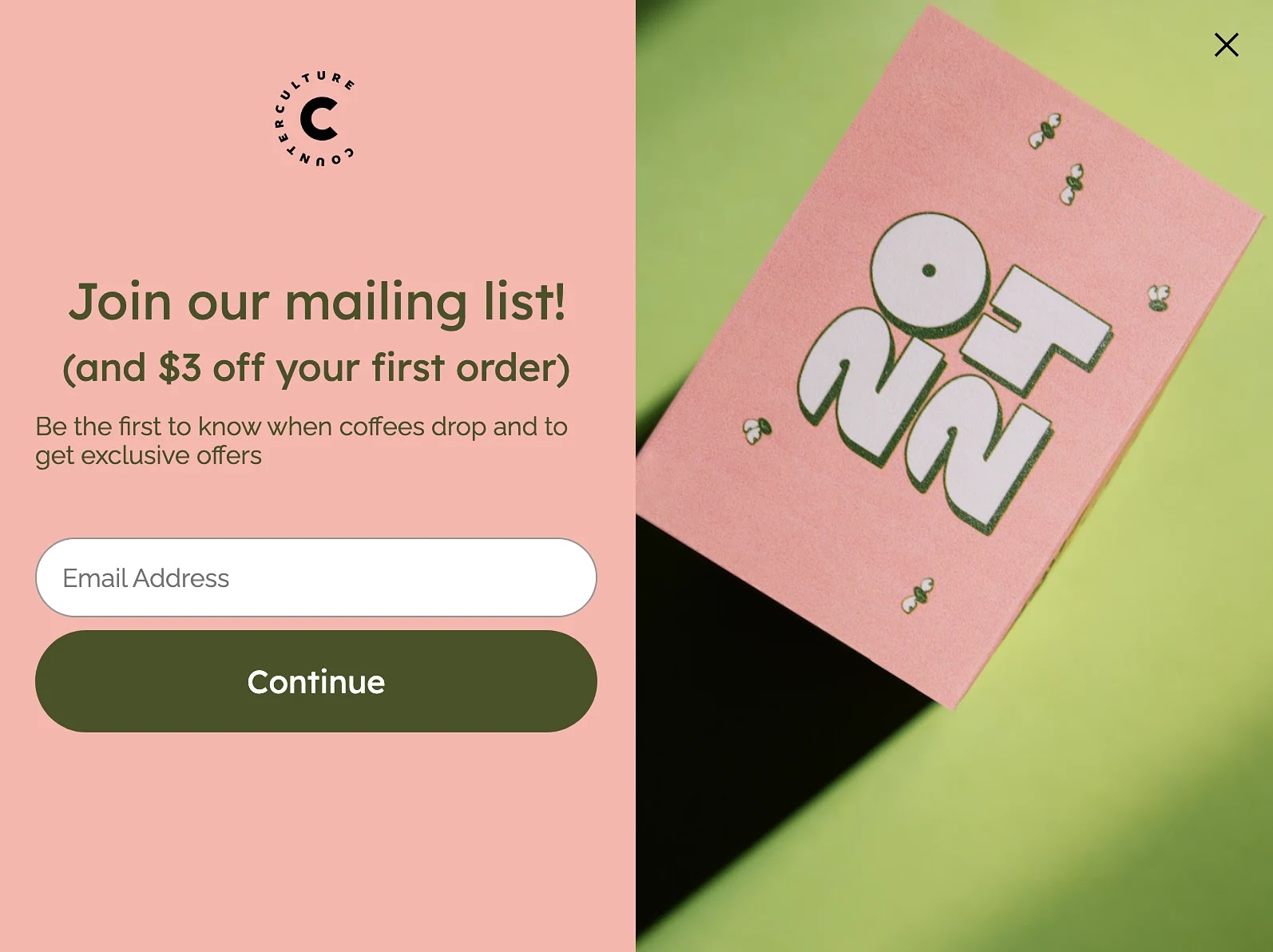
Participate in Online Forums
Joining and participating in online forums allows you to introduce your small business to your target customer. The more you contribute to online forums, the more chances you have to:
- Increase the visibility of your business
- Establish your own authority on a topic
- Spark interest in your business and prompt potential customers to search for it
Depending on your niche or industry, you’ll find relevant forums by searching:
- Slack
- Discord
- Circle
To meet your marketing goals (e.g., generate leads), follow forum guidelines. In many cases, that means writing posts or comments that are genuinely helpful rather than purely self-promotional.
Position Yourself as a Subject Matter Expert
Another way to establish authority in your field is to seek out opportunities to speak or write as a subject matter expert.
Here are some options to explore:
- Podcast interviews
- Speaking at in-person or virtual events
- Guest blogging for other websites in your industry
All of these outlets give you a platform to position yourself as an authority for your target audience. They can also lead to backlinks to your website, a key off-page SEO ranking factor.
Track these links with Semrush's Backlink Analytics.
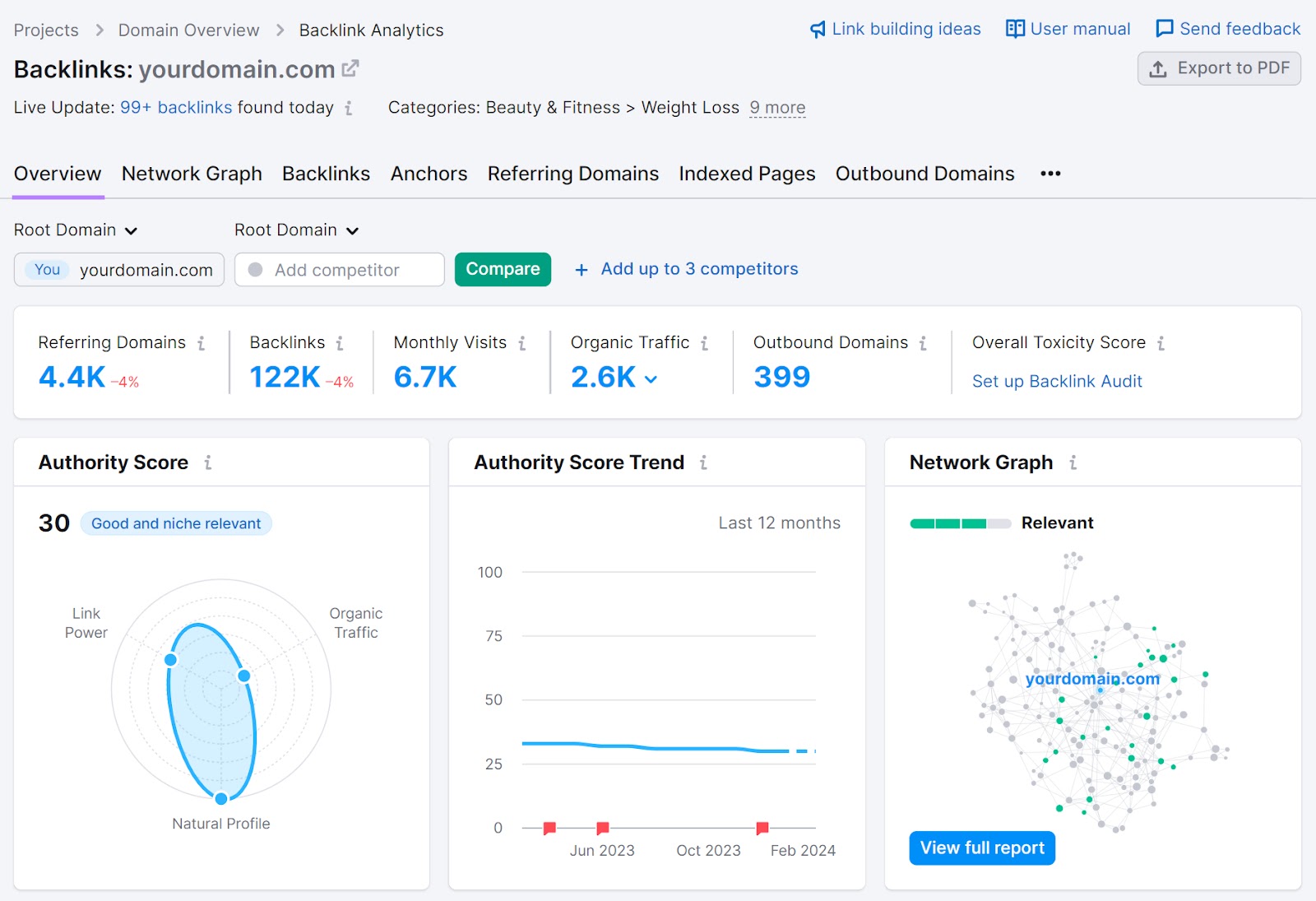
Backlink Analytics reveals the number of links your site has earned and the number of referring domains (unique websites that link to your site). It also shows your domain authority score, which reflects your site's quality and ranks its SEO performance.
Invest in Professional Branding
Professional branding makes your small business memorable, which can make customers more likely to buy from you and recommend you to friends and family.
Think of your brand as your business's identity. It should include both visual and written elements.
To establish a strong brand identity across marketing channels, start with:
- A logo that defines your business visually
- Typography and colors that appear in your logo and on your website
- Brand messaging and a style guide to communicate consistently with customers
Use a CRM System
A customer relationship management (CRM) tool is software that keeps track of all your prospects and customers. Think of it as a customer database.
Most CRM tools store customer data like:
- Names
- Addresses
- Phone numbers
- Email addresses
Use a powerful marketing tool like Semrush CRM to keep track of details like purchase or order amount and customer status (e.g., lead or active customer).
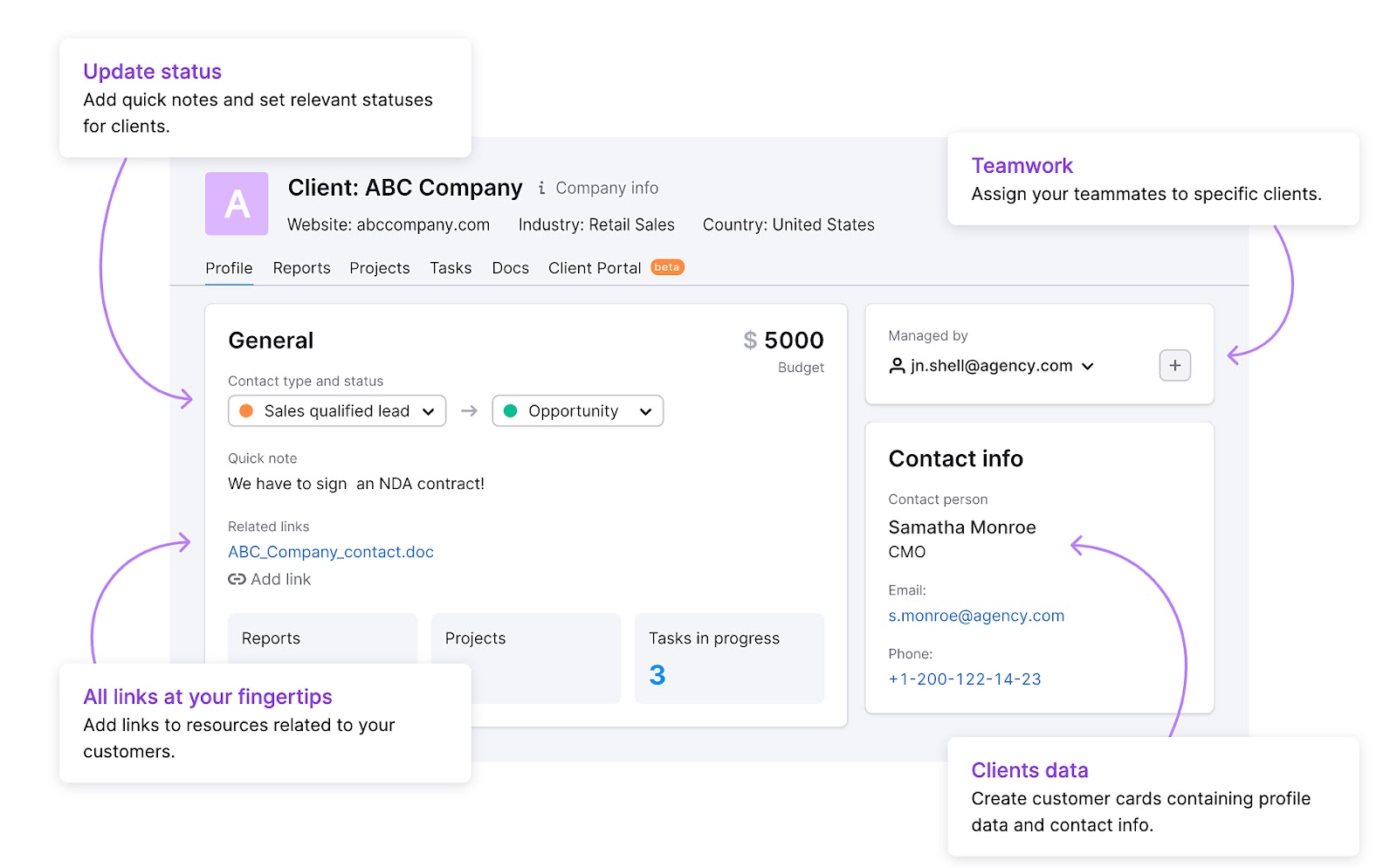
Advertising and Promotional Tips for Small Businesses
With advertising and promotions, you can grow your business via sponsored content, affiliate marketing, and product or service bundles. Many of these tactics use sponsored content or paid promotions, which sets them apart from the organic methods above.
Explore Paid Advertising
Paid advertising is ideal for reaching more potential customers more quickly. This tactic can increase awareness of your business, drive traffic to your website, and get conversions, like purchases, newsletter signups, or other customer actions that drive business outcomes.
As a small business owner, you have many advertising platforms available to you. Most fall into one of two groups:
- Social media ads: Reach prospects as they scroll through content on Facebook, Instagram, LinkedIn, and other social media platforms
- Pay-per-click (PPC) ads: Reach prospects as they search for information or shop for products and services using Google, Amazon, and other search engines
Which online advertising platform(s) should you choose?
- Social ads often work best for improving awareness, and remarketing to (also called retargeting) customers who have already purchased from or shown interest in your business
- PPC ads often work best for connecting with prospects as they show an active interest in or intent to purchase the solutions you offer
To get started with Google Ads (formerly Google AdWords), use the PPC Keyword Tool.
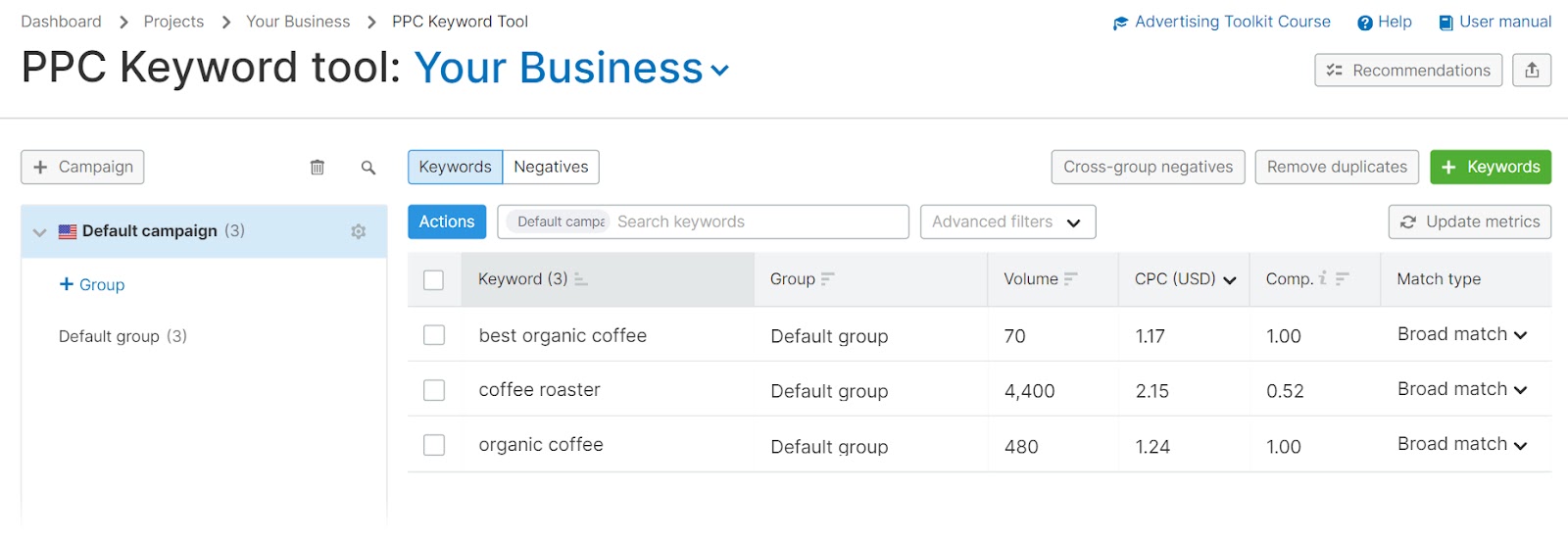
It helps you group paid keywords, see how competitive your keywords are, calculate total search volume, and assess average cost per click (CPC).
To make the most of a small marketing budget, you'll generally want to seek out keywords with high search volume but relatively low competition and CPC.
Bundle Products or Services
Bundling products and services together is an efficient way to encourage customers to make larger purchases. Instead of buying one item, they purchase many, increasing the average order value (AOV).
To create bundles that appeal to customers:
- Pair complementary products or services that customers often purchase separately to invite them to make the entire purchase with your business
- Group bestselling products that customers often buy with less popular products to prompt them to explore more of your offerings
- Upsell customers by adding a bonus item to a basic product or service to encourage them to spend more with your business
For example, Levain Bakery offers over a dozen cookie bundles based on cookie types and seasonal themes.
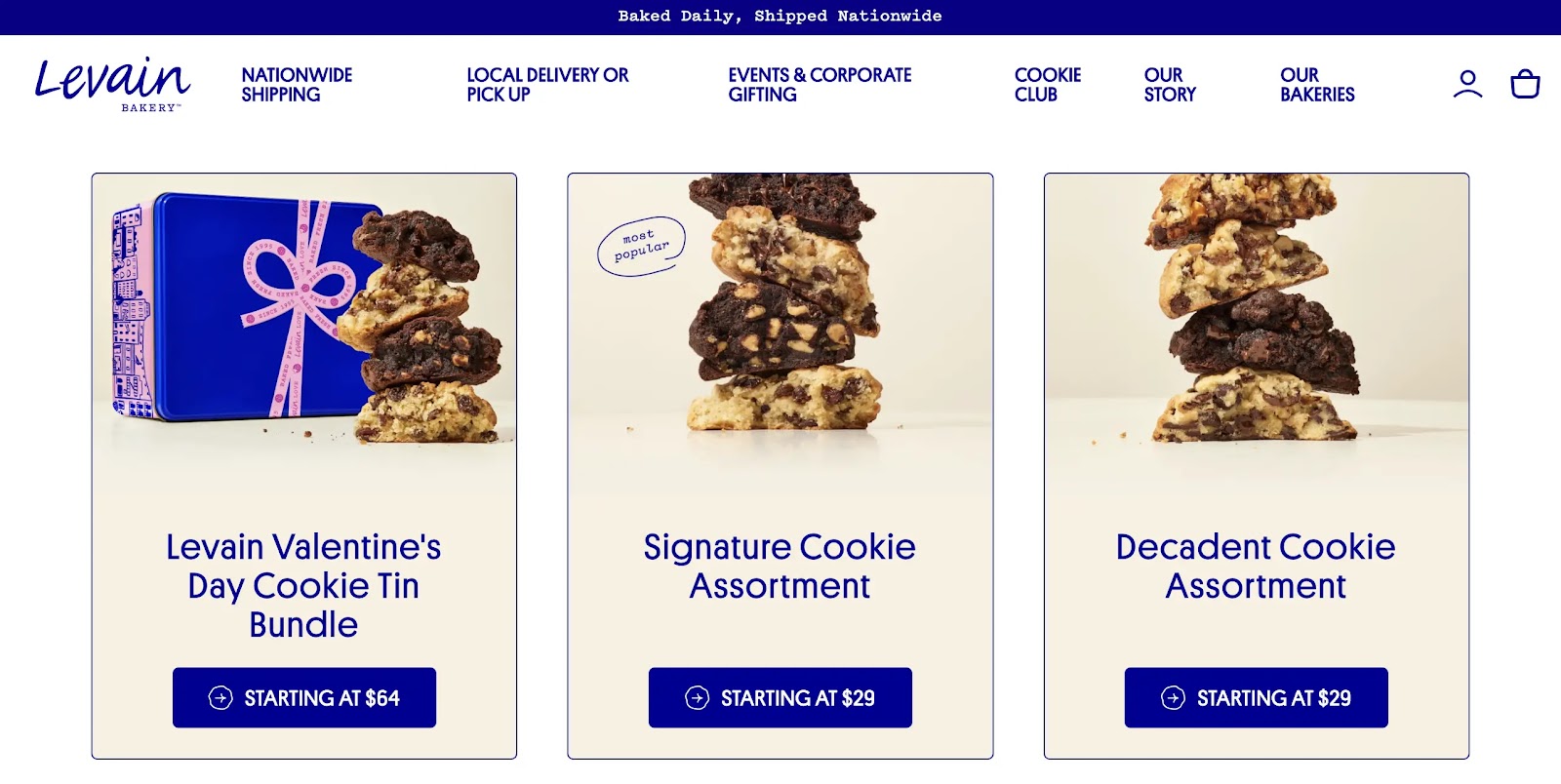
Incentivize with Giveaways and Contests
When you run contests, you essentially give away products and services at no cost to the consumer. That may not sound like a great way to grow your business, but it can be a surprisingly effective tactic.
Why?
Because giveaways can generate significant interest in your business, increasing awareness and interest. Depending on the entry method, they can also attract more social media followers or build your email list.
In fact, running Instagram contests can help brands grow followers 70% faster, according to Tailwind.
Here's an example:
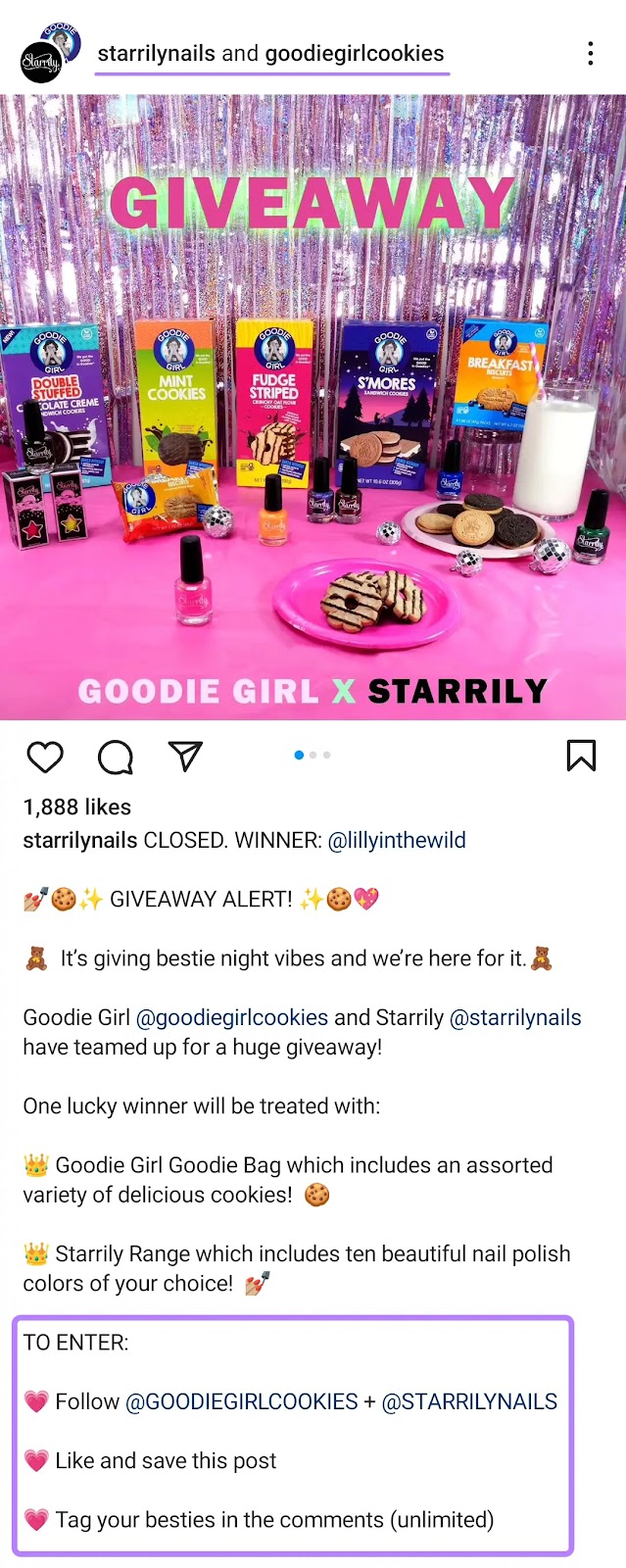
Above, the Goodie Girl and Starrily giveaway features gift bags from both brands. To enter the contest, participants must follow both brands' Instagram accounts and engage with the giveaway post.
Engagement is a ranking signal for the Instagram algorithm. That means generating a lot of likes and comments in a short amount of time can help more people see your post and enter your contest.
Create an Affiliate Marketing Program
Affiliate marketing uses a network of loyal customers and brand ambassadors to sell products and services on behalf of your business.
What's in it for them?
In exchange, you pay affiliates a commission for every sale. In some cases, you may pay a percentage of the total sale. In other cases, you may agree to pay a flat fee.
Using affiliates can be a smart marketing initiative for businesses with small teams and limited budgets. Instead of handling marketing efforts independently, you outsource them—and only pay for sales.
Here's an example of an X post by an Odylique affiliate:
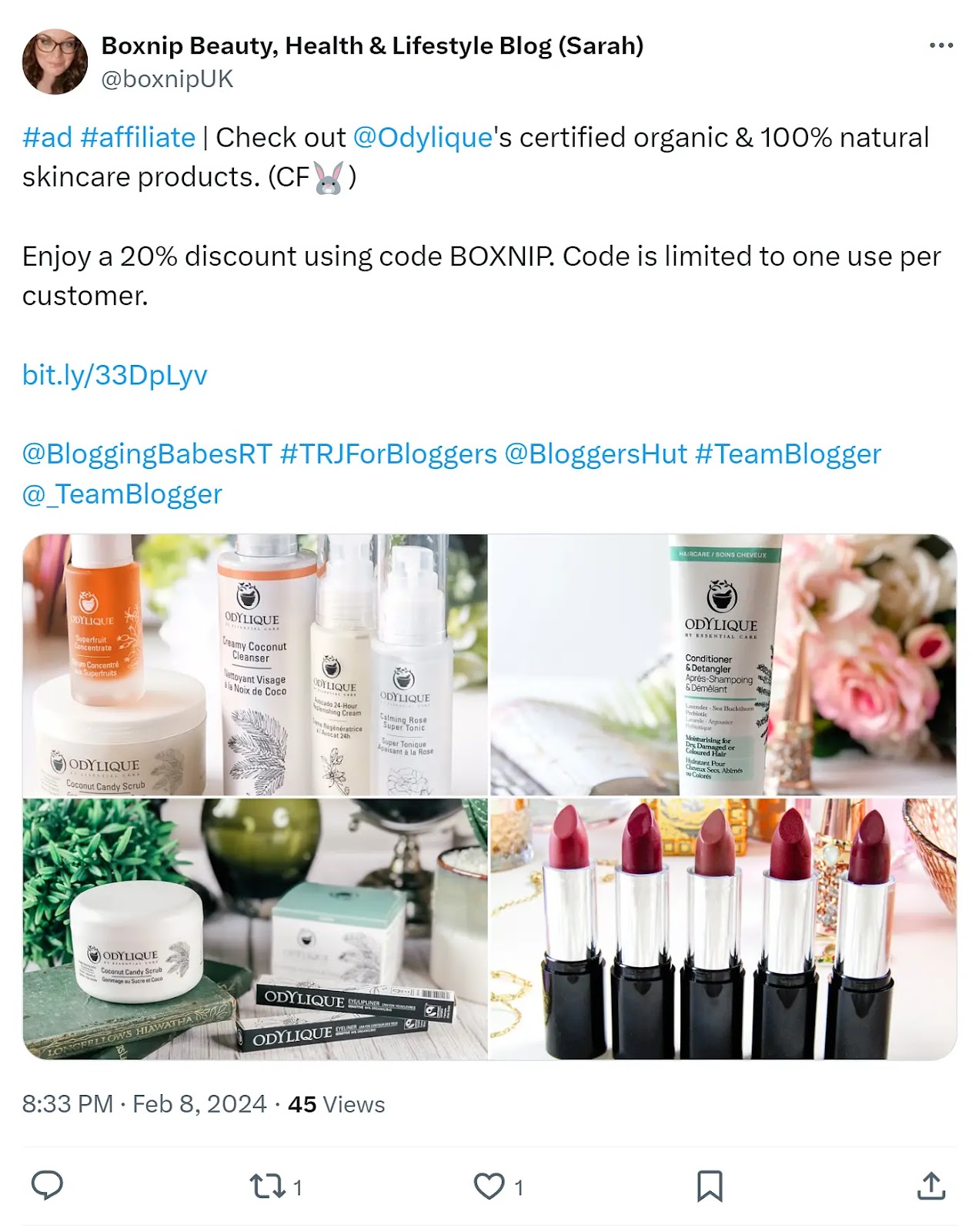
To build a successful affiliate program:
- Start by recruiting happy customers who are already advocates for your brand
- Provide tracking links so you can attribute sales to affiliates
- Give affiliates marketing materials and brand messaging to use in their posts
Customer Engagement and Relationship Building Tips for Small Businesses
Creating stronger relationships with customers can result in increased loyalty and more sales. In fact, increasing customer retention rates by only 5% can increase profits by up to 95%. As a small business owner, you have several options for meaningful interactions with customers online and offline.
Build Customer Relationships
Prioritizing strong relationships with customers is a great way to cultivate a customer base that's both happy and loyal.
Why do loyal customers matter so much?
Small businesses can save money by retaining happy customers. In fact, new customer acquisition costs up to five times more than customer retention, according to Outbound Engine.
As a small business owner, you can also generate more revenue by focusing on your top customers. Your most loyal 10% of customers spend about twice as much on each order compared to the other 90% of your customers, according to Smile.io.
How can you build better relationships with customers?
Use a tool like Semrush CRM to manage customer relationships. It keeps track of customer status, stores contact information, and adds internal notes to keep your team in the loop.
Create a Loyalty Program
Loyalty programs incentivize customers to make repeat purchases. As a result, they can drive more sales and increase customer lifetime value (the total profit throughout a customer relationship).
Here's how they work:
Customers receive points for buying from your small business. They then redeem points for discounts or free add-ons, encouraging them to make more purchases.
When customers want to accumulate more points or redeem them, they'll be more likely to buy from your business instead of going to a competitor.
Here's an example:
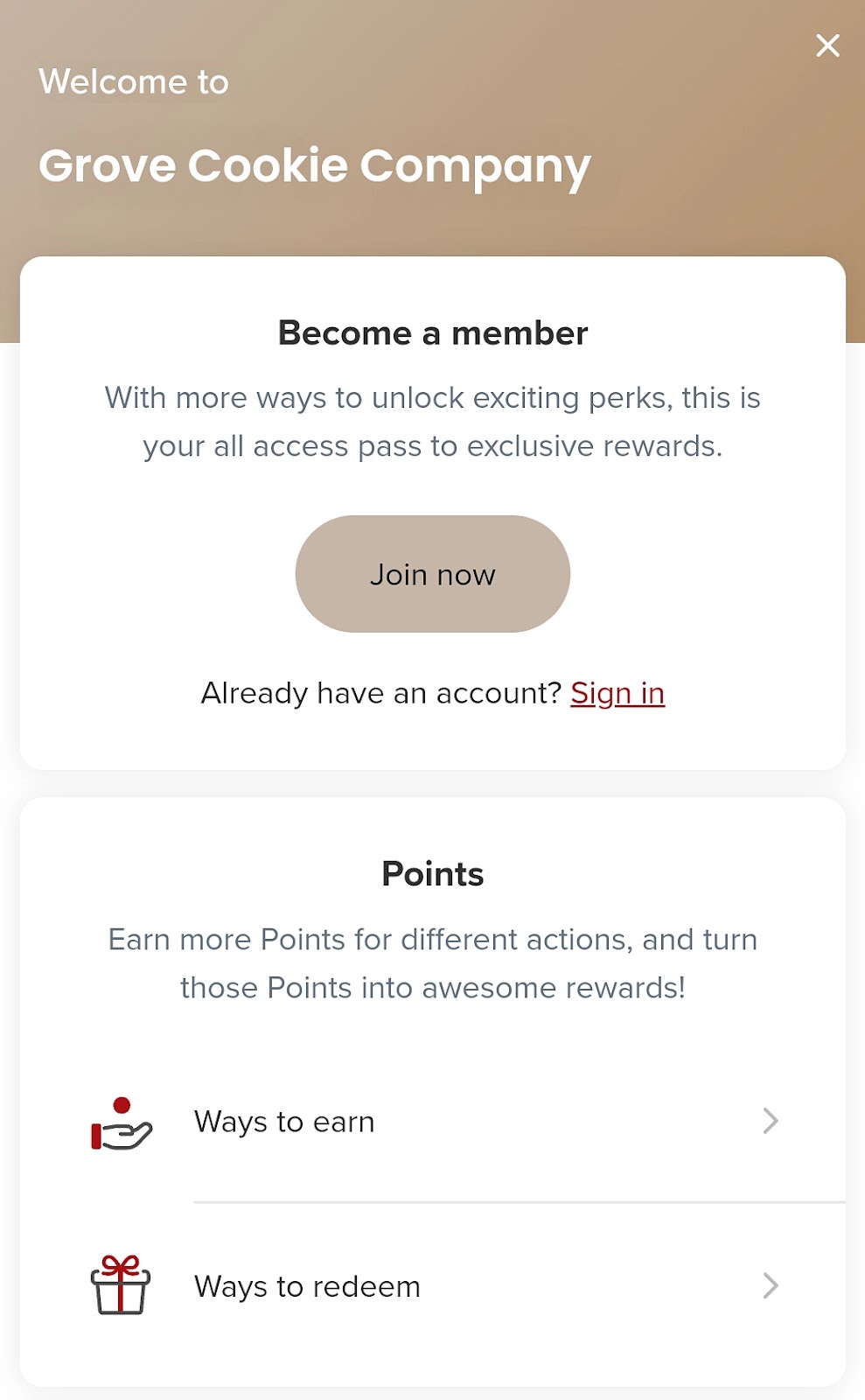
Grove Cookie Company has a loyalty program that offers points for purchases, social media engagement, and email subscriptions. Members can earn points and access exclusive promotions.
Run Limited-Time Promotions
Limited-time promotions create a sense of urgency and encourage customers to make decisions quickly. This tactic can attract new customers and prompt loyal customers to make repeat purchases.
Why?
Creating a sense of urgency is a psychological tactic that gets customers to buy a special promotion right away rather than taking time to think about it—and possibly deciding against it.
Instilling this fear of missing out (FOMO) can increase sales by 332%, according to CXL.
How should you drive sales with a limited-time discount?

Above, the Cloth and Paper Instagram reel features a one-day promotion: a free notebook with a purchase of another item.
Offer Free Trials or Samples
Free trials or samples let prospects experience your products or services without paying for them. This small business marketing idea can attract and convert new customers.
The idea is that if customers like what they try, they'll make a purchase. Here's how to use this type of online marketing to increase the likelihood that customers will actually buy.
For a service-based business, offer a free trial for a certain period of time. Set it up so that it automatically turns into a paid service when the trial ends.
For a product-based business, add free samples of another product to a customer's order. Then, follow up with a promotional email offering a discount for the sample product.
Host Webinars or Online Workshops
Webinars and online workshops are great for educating potential and existing customers.
Here's how:
Webinars can work as lead generation tools that guide prospects toward a purchase. To produce a webinar for lead generation, choose a topic that relates to a problem your target market needs to solve. Then, position your product or service as the solution.
Online workshops also help existing customers get more value from your products and services. As a result, they can improve customer retention.
Here's an example:
Semrush Academy has dozens of webinars on content marketing, search engine marketing, affiliate marketing, and other channels. Each one addresses customer problems and pain points while positioning Semrush products as helpful solutions. As a result, Semrush Academy works as a lead generation tool.
Ask for Customer Feedback
Customer feedback is critical for growing a small business. When you ask customers what they think or how they feel about your business, you get invaluable ideas to improve your offerings.
You don't have to wait for customers to offer opinions. Instead, ask them directly.
For example, send a survey to your mailing list or publish a poll on social media. Then, make a plan to implement changes or address customer concerns.
Customer feedback gives you ideas for:
- Developing new products or services
- Bundling products or services
- Discontinuing products or services
- Revisiting your pricing structure
- Offering more educational materials
- Changing your operating hours
Monitor Your Online Reputation
Online reputation management is the process of monitoring and responding to customer reviews and feedback. It's essential for addressing negative reviews and building relationships via positive reviews.
Why is it such an important part of your marketing plan?
Before deciding to make a purchase, 99.75% of shoppers read online reviews, according to Power Reviews. By managing your reputation, you ensure your business makes a positive impression.
With Semrush's Review Management tool, you'll get alerts when you receive new customer reviews. This tool also monitors your business's average star rating.
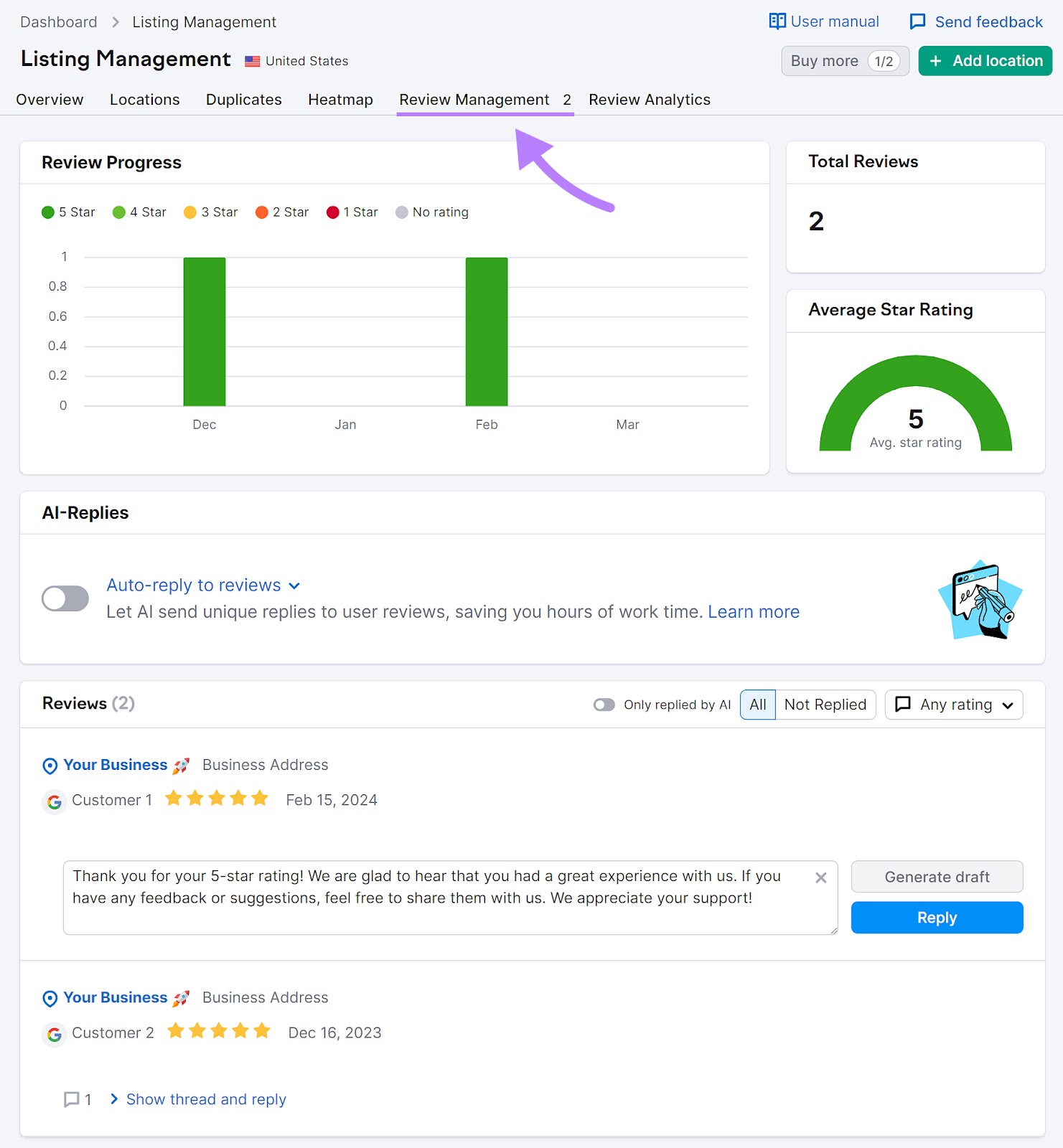
Review Management also responds to reviews automatically. If your business receives a lot of reviews, this feature can save you a ton of time.
Networking and Collaboration Tips for Small Business
By networking and collaborating with fellow business owners or local organizations, you reach more prospects and convert more customers. Here are five ideas to use these methods online and in person.
Attend or Host In-Person Events
Attending or hosting in-person events can increase visibility for your small business. It’s also helpful for creating deeper connections with potential customers.
But attending in-person events is more time-consuming and expensive than logging in to virtual events.
So, you have to be selective. To find relevant events in your niche:
- Join your chamber of commerce for local networking events
- Use online databases in your niche to find larger events
To get maximum value from in-person events:
- Review the list of speakers beforehand and make a list of talks to prioritize
- Budget plenty of time for networking with fellow attendees
- Exchange business cards and follow up after the event
Participate in Trade Shows
Trade shows can help business-to-business (B2B) companies expand market share and meet sales goals. They're a traditional marketing channel that provides a platform to pitch your business, generate leads, connect with potential business partners, and stay on top of small business trends.
Use these tips on marketing a small business to maximize trade show ROI:
- Design a trade show booth that's both eye-catching and engaging
- Create marketing materials to distribute to prospective customers and partners
- Practice your 30-second pitch to introduce your business and efficiently gauge interest
- Be prepared to capture leads by scanning badges or collecting business cards
Sponsor a Community Cause
Sponsoring a community cause is a great way for local businesses to support people and organizations in the area. Sponsorships can also:
- Raise awareness of your business
- Enhance trust in your business
- Connect your business with a cause that aligns with its values or mission
To find community causes to support, search for local nonprofits or charities. Then, ask about their programs to determine whether they fit your budget and whether you can spare the necessary time.
Cross-Promote Your Business
Cross-promotions are marketing efforts that help multiple businesses reach a larger audience. They typically feature two or more complementary businesses that have some audience overlap.
Here's an example:
Below, the NYX Cosmetics Instagram reel features a cross-promotion with four other businesses. By hosting a giveaway with complementary businesses, each brand can reach and engage more potential customers than they could when marketing alone.

Below, the Celsius Instagram reel features a cross-promotion with Orangetheory. The video announces the launch of the fitness drink in fitness studios nationwide.

Develop Strategic Partnerships
Strategic partnerships are longer-term agreements with other businesses. Think of them as referral programs that help both businesses gain more customers and make more sales.
Like cross promotions, strategic partnerships tend to work best with businesses that offer complementary products or services.
Here's an example:
Say you run a small design studio that builds custom websites. Your clients often need relevant content to publish on their new websites.
You could form a strategic partnership with a small SEO or content marketing agency that has clients who need custom website design.
Together, you could agree to sell package deals to these clients. Or you could agree to refer all clients to each other in exchange for a referral fee.
Strategic Planning and Development Tips for Small Business
With strategic planning and development, you can develop long-term marketing programs for your small business. The tactics below can inform your digital marketing, advertising, collaboration, and engagement strategies.
Develop a Strong USP
For new entrepreneurs, one of the most important small business marketing tips is identifying your unique selling proposition (USP). Your USP is what differentiates you from the competition.
It's a short (one- or two-sentence) statement that clearly communicates what sets your business apart. Use your USP in your marketing materials to share what makes you unique.
Here are some selling points to consider:
- Pricing: Such as being the least expensive option on the market
- Popularity: Such as being the preferred option in your niche
- Location: Such as being the closest to a landmark
- Service: Such as having the most devoted customer service team
- Innovation: Such as having unique products or services
How do you decide?
You need audience and market research to differentiate your business from the competition.
Use Market Explorer to research specific groups of competitors or entire industries. To define your market, enter up to 100 competitors. Then use the analysis to understand your audience and your competition.
The "Growth Quadrant" shows how quickly each competitor is expanding. Use it to understand the competitive landscape and confirm which businesses you should differentiate from.
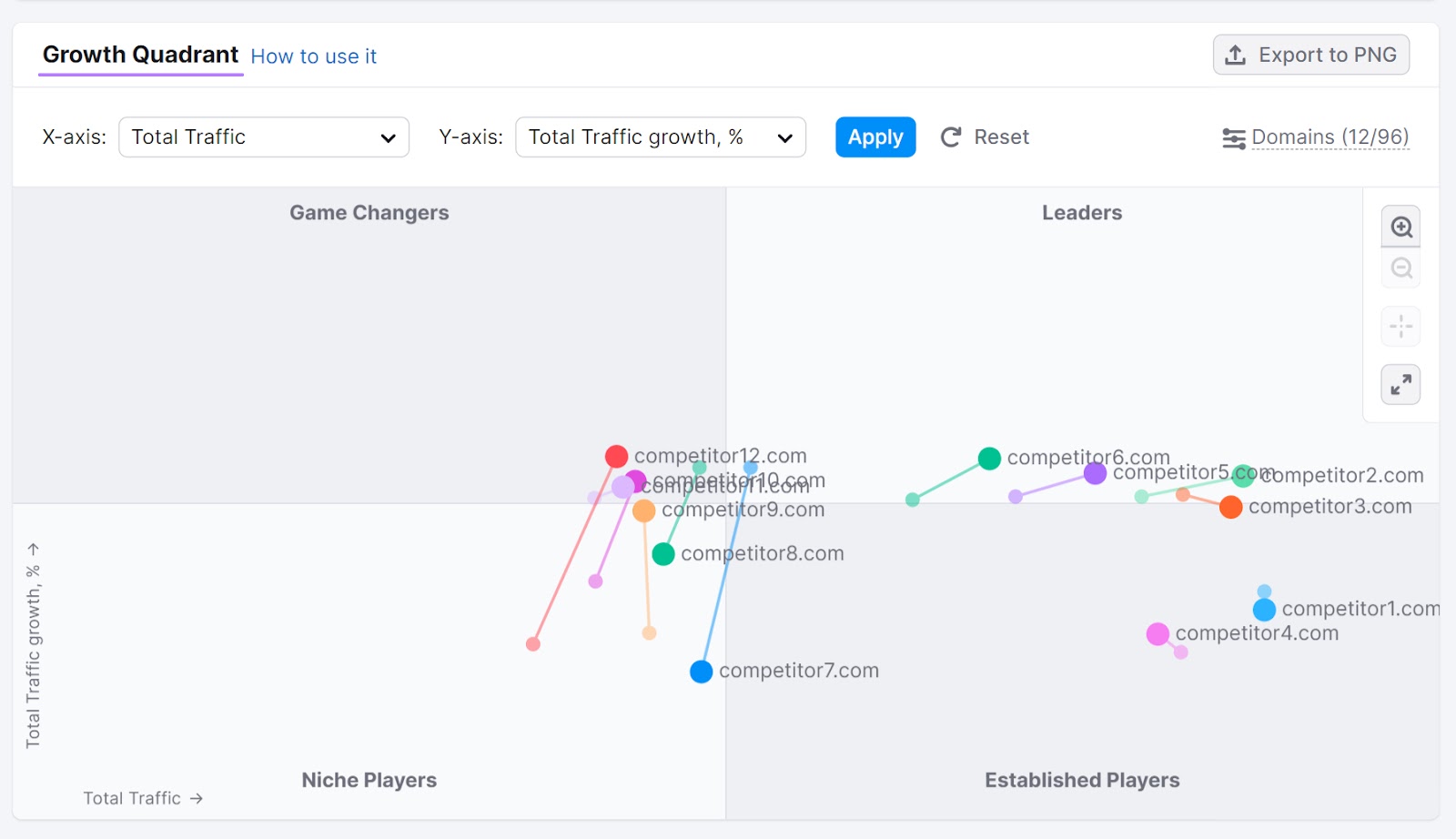
The "Market Audience Summary" reveals demographic, socioeconomic, and behavior data for your target audience. Use this data to design a USP that appeals to your ideal customer.
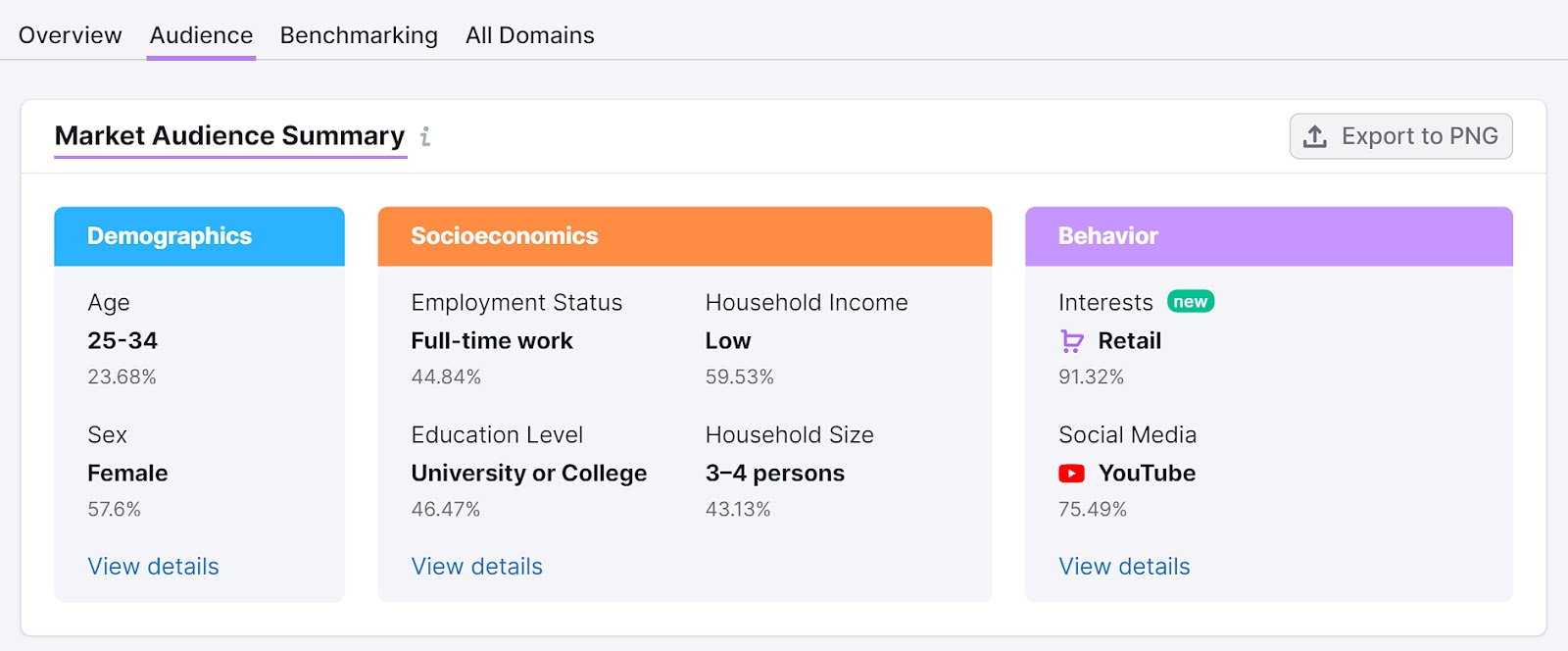
Conduct Market Research
For any small business owner, market research should be an ongoing effort. This tactic can help you stay competitive as the market evolves, customers change, and new businesses enter the industry.
Use Market Explorer to assess the total addressable market, measure market traffic, and identify key players. Then, monitor these metrics for changes over time.
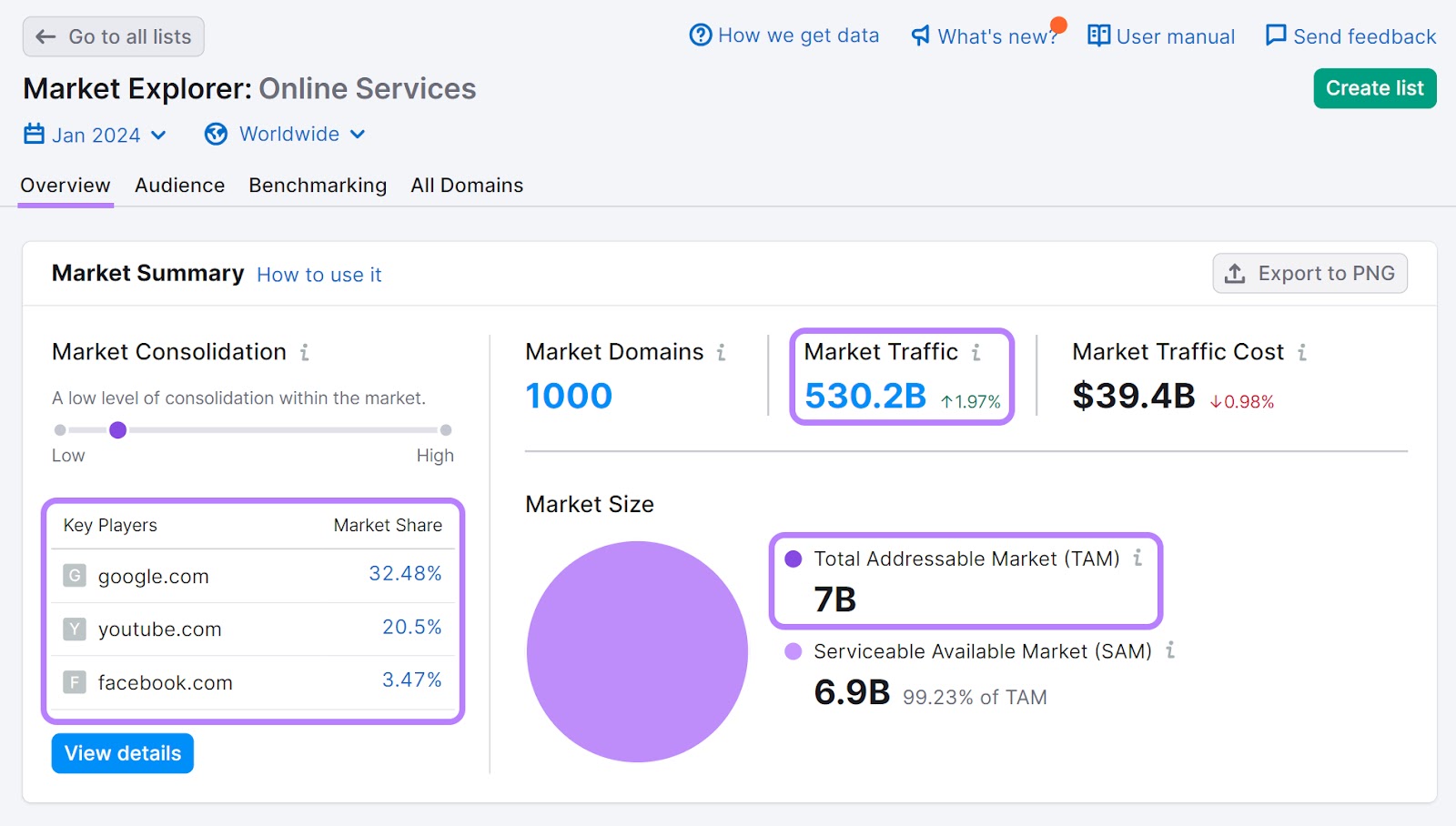
On the "Benchmarking" tab, you can select up to five competitors and compare them to each other. And against market traffic.
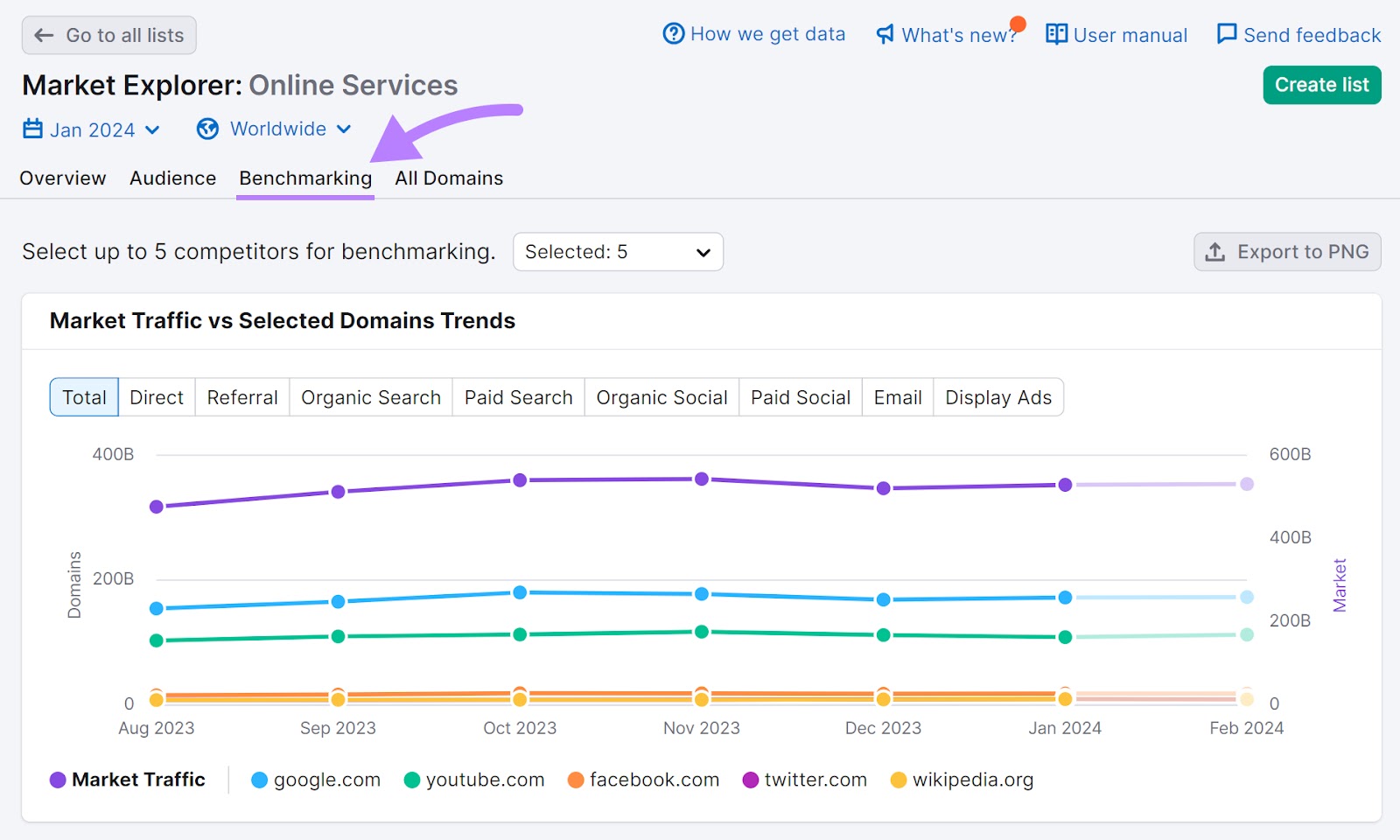
Use Data Analytics
Every small business needs data analytics to understand and respond to customer behavior. Using a website analytics tool like Google Analytics is a good starting point.
Google Analytics reveals how visitors navigate and engage with your business content. Use this tool to track metrics like:
- First visit, which shows whether you're continuing to attract new customers
- User engagement, which is the amount of time visitors spend actively using your site
- Scroll depth, which shows how far users scroll down a page before exiting
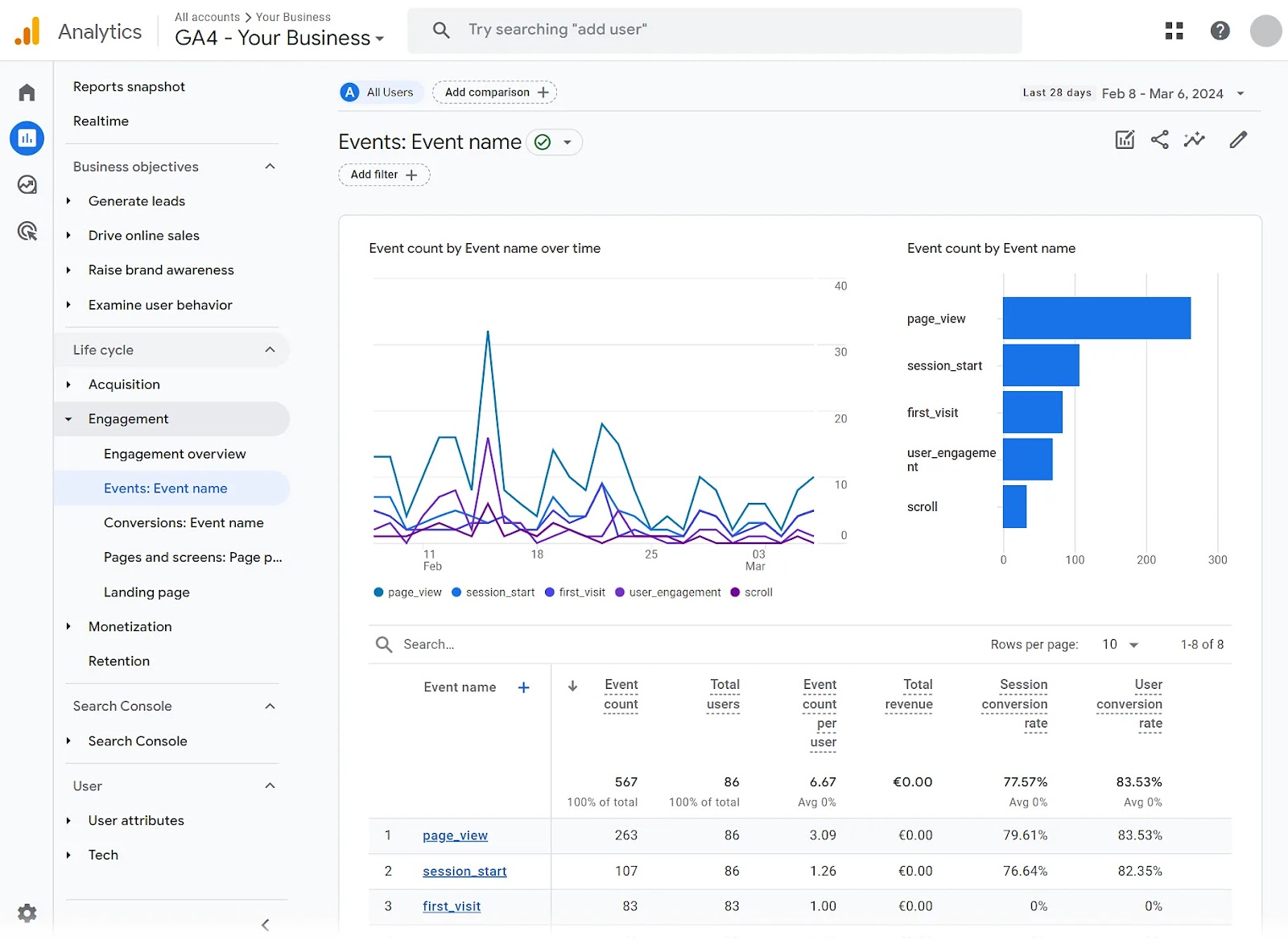
You can also configure custom events based on how your customers convert. For example, you can track leads and purchases using Google Analytics.
Then, review your website's data analytics regularly (e.g., monthly and quarterly) to see which pages drive the most engagement and conversions. Then, make a plan to develop more content like your top-performing pages or promote them via email and social media.
Automate Where Possible
Automation can save small business owners substantial time. Automating simple tasks frees up time to develop more ambitious business marketing strategies.
Where should you start? It depends on the marketing channels you use and the time you spend.
Here are some ways Semrush helps you automate:
- Schedule social media posts to publish automatically with Social Poster
- Respond to local business reviews automatically as soon as they're posted with Review Management
- Generate marketing reports automatically with My Reports to free up more time to analyze them
With 55+ tools, Semrush helps you automate these tasks—and many more.
Future-Proof Your Small Business Marketing
As a small business owner, you have access to a wide range of both online and in-person marketing tactics, from SEO and social media to trade shows and loyalty programs.
You probably won't have the time or budget to implement all 30 of these tips at once. Instead, start with one. Then, put more into action when you have the right resources and tools.
One software platform helps you efficiently and cost-effectively manage many marketing channels. Semrush has 55+ tools for SEO, social media, market research, advertising, and more. Try it free today.
